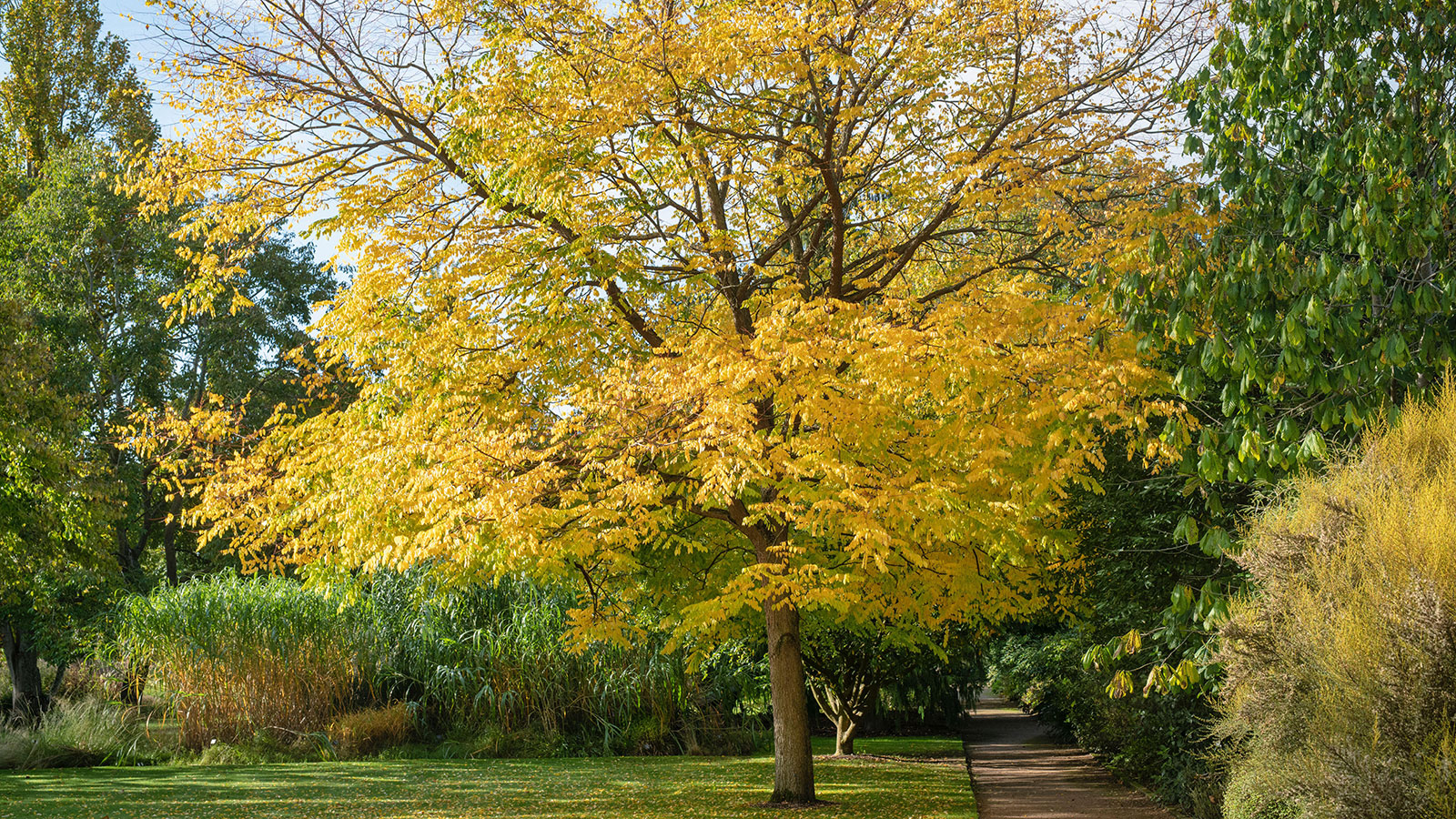
If you’re looking for a robust, ‘climate-smart’ tree that will cope with the weather extremes the US has experienced in recent years, look no further than the Kentucky coffeetree (Gymnocladus dioicus). Not only does it offer superb ornamental value through all the seasons, but it also copes with dry, wet and freezing conditions.
With its spreading oval to round crown, and huge, fern-like leaves, the Kentucky coffeetree is a great tree for shade, offering a dramatic shade canopy in summer. The leaves, often growing up to three feet long, are briefly tinged pink in spring, turning bluish green. In fall, the eye-catching purplish brown seed pods contrast beautifully with the foliage as it turns golden. The pods persist on the tree for most of winter.
Its intriguing common name comes from the early Kentucky settlers who used to roast the seeds as a coffee substitute. This must have been a risky business, as the seeds and pods are regarded as highly toxic by today’s standards. Despite the kooky common name, this cold hardy native tree is nothing like the proper coffee tree from the tropics. It grows naturally in the middle region of the US, from Pennsylvania to Nebraska and from Minnesota to Oklahoma, and can tolerate temperatures down to -40˚F. It’s a member of the pea family (Fabaceae), whose relatives include gleditsia, lupin and laburnum.
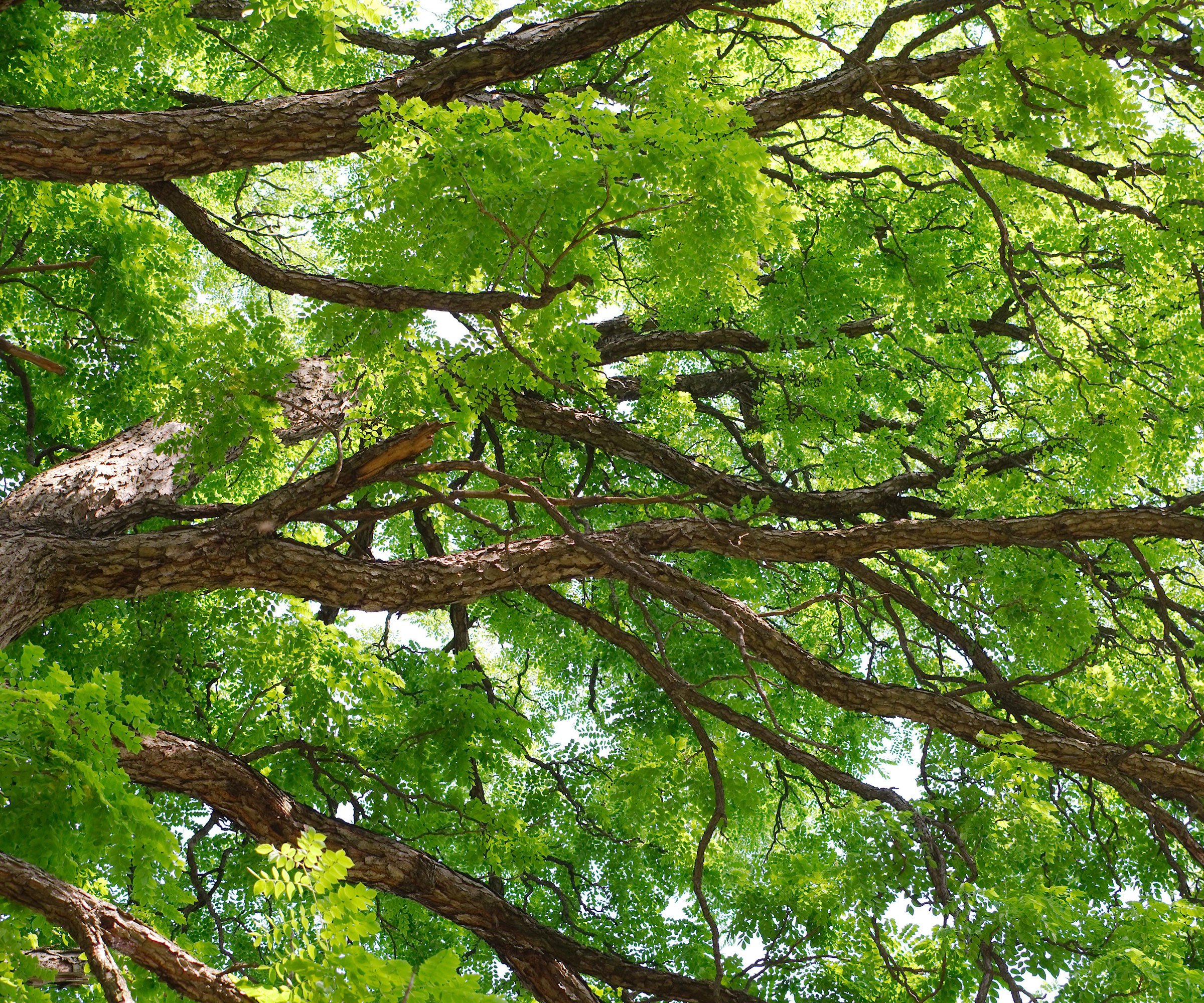
Kentucky coffeetree tree: key facts
- Plant type: Deciduous tree
- Mature size: 60ft x 40ft over 50 years, slow growing
- Soil type: Broad tolerance but prefers deep fertile loam
- Soil PH: Broad tolerance
- Time of year to plant: Dormant season, November to April
- Flowering time of year: Summer
- Flower color: Small star-shaped, greenish-white
- Hardiness zones: USDA 3-8
- Scientific name: Gymnocladus dioica
- Common names: Kentucky coffeetree, chicot
Types of Kentucky coffeetree
The seedpods are only produced on female trees, so if you don’t want to be sweeping up seedpod litter in winter, choose male-flowering named varieties like ‘Espresso’ (available at Nature Hills) and ‘Decaf’, (also from Nature Hills). These varieties won’t grow as tall as the wild species so are a better option if you need a tree for a small backyard, although they’ll still reach 50ft eventually.
Because the male and female flowers are on separate trees, both are required to achieve the seedpods on the female tree. The male trees have small cream-colored flowers that are easy to miss, while the female panicles are showier. If you live in a region where other Kentucky coffeetrees are growing, you might get lucky with pollination. 'The flowers are cross-pollinated by bumblebees, long-horned bees, tiger swallowtail butterflies and the ruby-throated hummingbird,' says Illinois Wildflowers.
Arguably, it's the seed pods – only produced on female trees – that give this tree its unique winter look, together with its textured bark and rugged winter silhouette. It’s sometimes referred to as the ‘Halloween tree’ due to the fact the leaves drop early in fall, revealing its contorted winter branches. The seedpods hanging from the naked branches only add to its haunted house look.
'Kentucky coffeetree is not a common tree to find at most garden centers, but with a little searching it can be found,' says Roger Davis, Outdoor Landscape Manager at Longwood Gardens in Pennsylvania. 'Garden centers should provide the gender for the tree.'
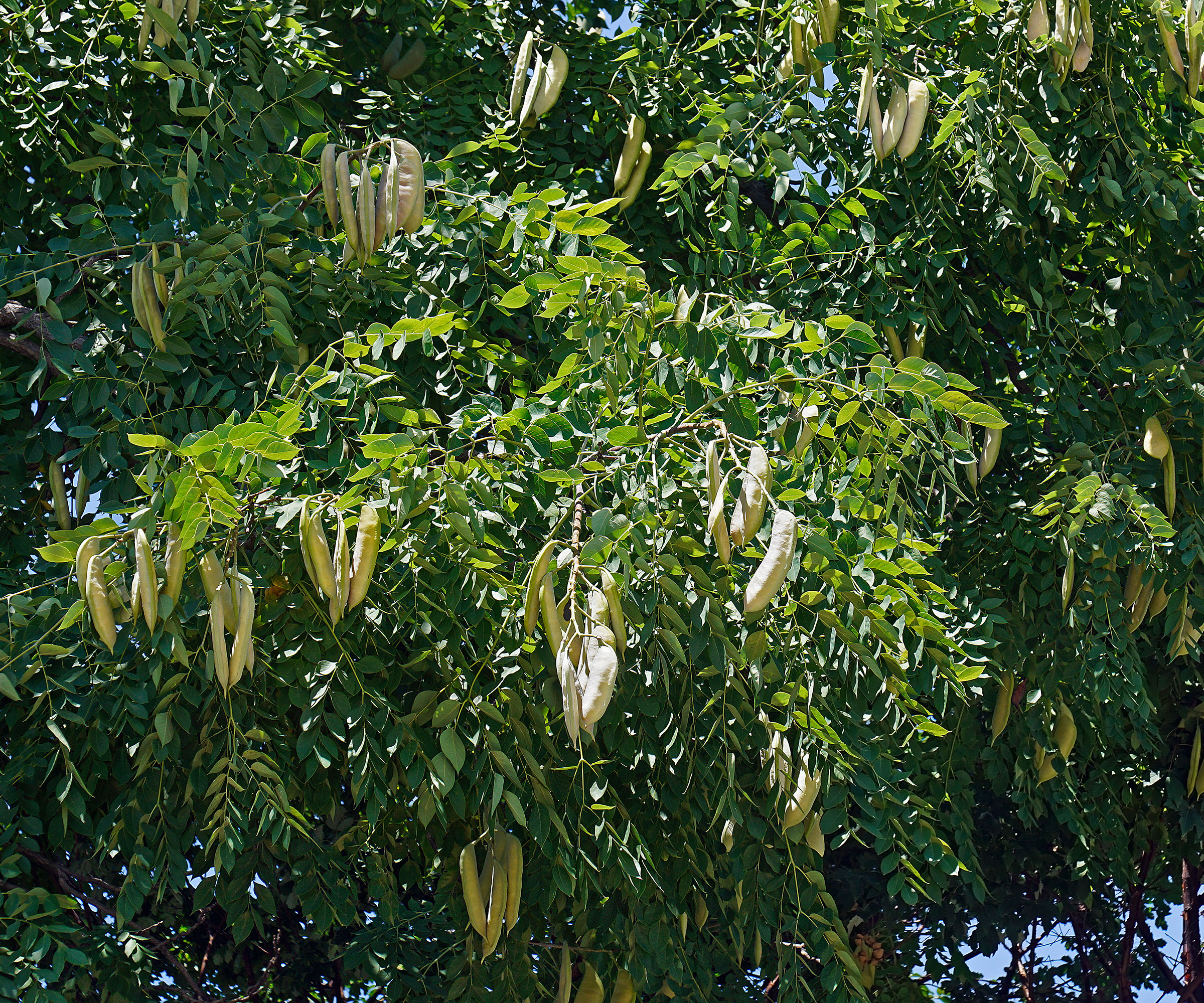
How to use Kentucky coffeetree in your yard
Whether you're searching for a tree for a front yard or backyard, you’ll need a medium to large space to grow the Kentucky coffeetree, for it reaches over 60ft eventually (within 50 years). It’s a fast-growing tree initially but slows down once established, putting on between 12 to 24 inches per year. The national champion tree, 97 feet tall, is in Maryland, according to the University of Kentucky.
It’s one of the last trees to leaf up in the spring (late May to early June) and loses its leaves early in fall, so make sure you include plenty of evergreen trees and shrubs to provide color earlier in the season.
Because the shade it creates is light and airy (semi-shade) it’s possible to landscape around the trees with drought and shade tolerant plants. Nature Hills nursery recommends an underplanting of paw paws, redbud, chickasaw plums, and flowering dogwood.
If you have the space, you may want to create a natural grove. The Kentucky coffeetree is an attractive option in yards that need a windbreak or shelterbelt.
When, where and how to plant Kentucky coffeetree
To get your Kentucky coffeetree off to the best start, plant your tree in spring or fall, when the soil is warm and rainfall is higher, or over the dormant period (November to April). Avoid planting in summer or during periods of prolonged dry weather, and not when the ground is frozen in winter.
This tree needs full sun, so plant it somewhere it will receive a minimum of six hours direct sun a day. It’s very adaptable and will cope with dry or moist soil types, extreme heat and air pollution.
When it comes to how to plant the tree, start by digging over about 1 meter square around the planting location to loosen the soil. Remove any weeds and other plants so your tree is not competing for moisture and nutrients while it’s establishing. Improve the soil in the planting area with well-rotted manure or fertilizer, but don’t add these to the planting hole.
Dig a planting hole that’s only slightly bigger than the root ball. Carefully remove the tree from its growing pot and place it into the hole. Check the top of the root ball is level with the ground and backfill with the dug-out soil. Firm the soil using your heel, and make sure the tree is upright. Now apply a bucket of water to the planting area.
A tree stake (placed either vertically or at 45 degrees to the tree), will help support the tree for the first couple of years while its root system is establishing.
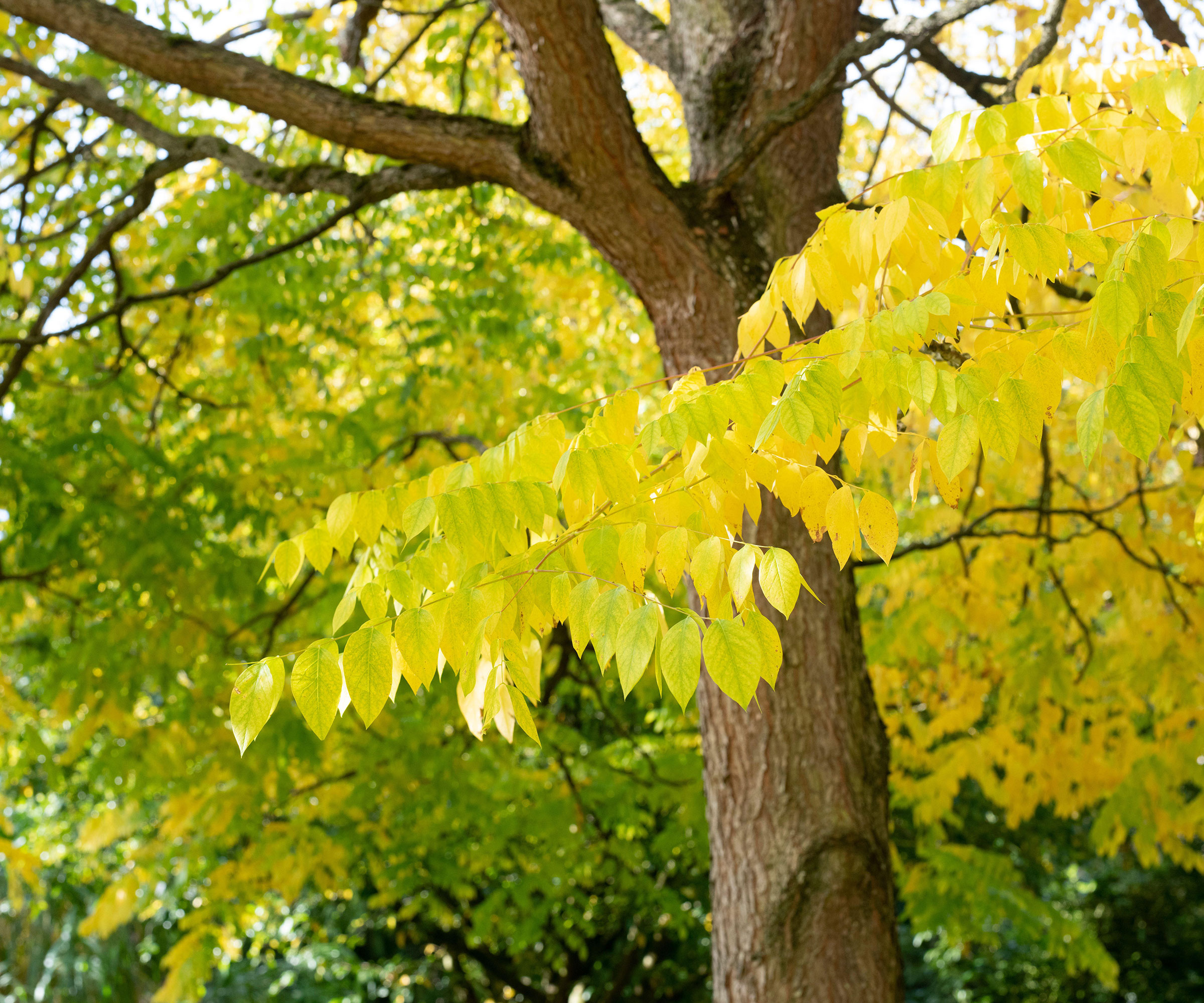
Care tips
Newly planted trees should be watered regularly through the first spring and summer. After the first season, trees need only to be watered during prolonged dry periods. Mulching with compost will help to keep moisture in the ground as well prevent weeds and grass from encroaching.
No routine pruning of Kentucky coffeetree is necessary, just remove any diseased, dead, or crossing shoots as required, in late winter or early spring.
The trees only need fertilizing when they’re young and after they’ve been pruned. In spring, sprinkle a general-purpose fertilizer (such as blood, fish and bone) over the root area before hoeing into the surface.
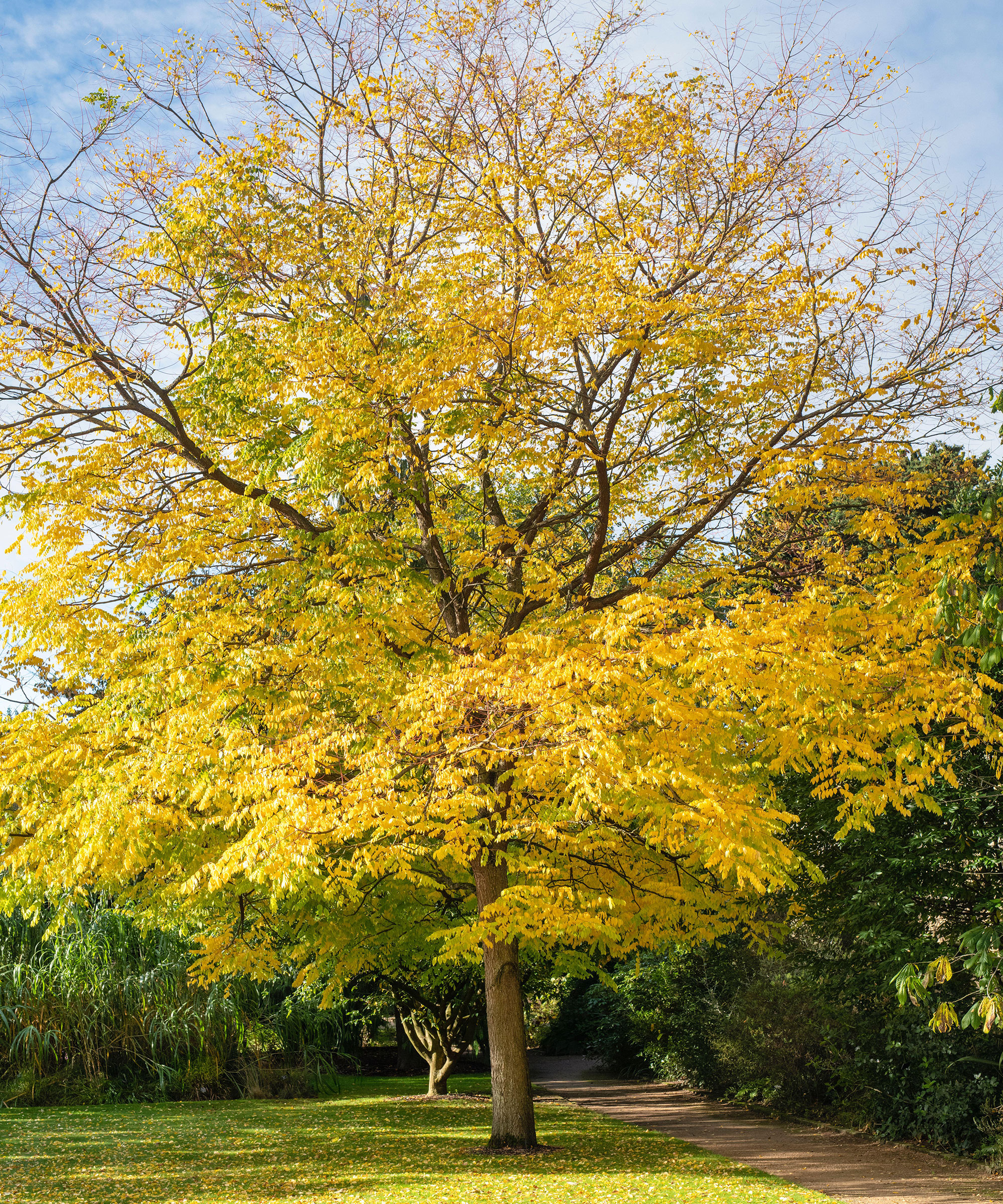
How to make more Kentucky coffeetree
The Kentucky coffeetree is a rare sight in the wild, and naturalists believe this is because the extinct ice age mammals that ate the tough pods and dispersed the softened seeds, died about 13,000 years ago. So why not give Mother Nature a helping hand and grow your own Kentucky coffeetree from seed? Patience is required, as it will take many years to grow a large tree!
The pods of Kentucky coffeetree can be collected any time after they turn from green to tan, but they will naturally fall from the trees in late winter or early spring, according to The University of Kentucky. 'Inside the pod surrounding the seeds is a sticky or dry-jelly like material. It contains toxic materials that should not be eaten. Discard misshapen or off-colored seeds.'
If there are no Kentucky coffeetrees with seedpods growing in your region, you could order some seeds from a reputable seed company such as The Incredible Seed Co, then follow the below steps:
- Store seeds in a refrigerator, in a bag filled with moist sand or vermiculite. If any begin to sprout, sow them straight away. Otherwise, wait until spring when you’ll need to soak the seeds in warm water for 24 hours to soften their tough coats and allow in moisture before sowing.
- Fill pots or modular seed trays with seed starting potting mix or use 50% all purpose potting soil with 50% perlite or coarse grit. Firm down the soil and water it, allowing the excess to drain out of the drainage holes at the bottom.
- Make a hole 1 to 2 inches deep and drop a seed into the hole and cover it with potting mix.
- Put the pots into a nursery tray and place them in partial sunlight. 'Heat mats are not required and can hinder germination,' says The Incredible Seed company. Keep the potting soil moist until germination occurs, usually within 2 to 4 weeks.
- 'Protect young tree seedlings from slugs, cutworms and rodents,' adds The Incredible Seed Company. 'Slugs especially can eat primary leaves as soon as they come up, so be vigilant.'
Common problems
These low-maintenance trees are generally problem-free. The young winter twigs are light gray in color, almost white. This is a naturally occurring bloom and not a sign of disease.
'Kentucky coffeetrees often sucker off their root system so you’ll find suckers coming up in the areas around a tree,' says Roger Davis. 'It’s not a problem but will need to be managed by removing them.'
FAQs
Are Kentucky Coffeetree beans edible?
The seeds and seedpods of the Kentucky coffeetree are toxic if eaten – something to keep in mind if you have pets and want to avoid plants that are poisonous to dogs. Bear it in mind if you have young children too, as they can be naturally inquisitive and may pick up the seedpods and try to eat them.
Roasting the seeds is thought to neutralize the toxicity, hence why early settlers got away with eating them, but this is not advisable today.
How fast does a Kentucky coffeetree grow?
It has a slow-to-medium growing rate once established, putting on between 12 to 24 inches per year.
As the Kentucky coffeetree is rarely troubled by pests and diseases, it makes a great alternative to ash and elm, which are now, sadly, very disease prone.
Providing you choose a relatively sunny spot for it to grow, this deciduous tree is low maintenance and fairly adaptable, and would make a charming addition to most backyards.







